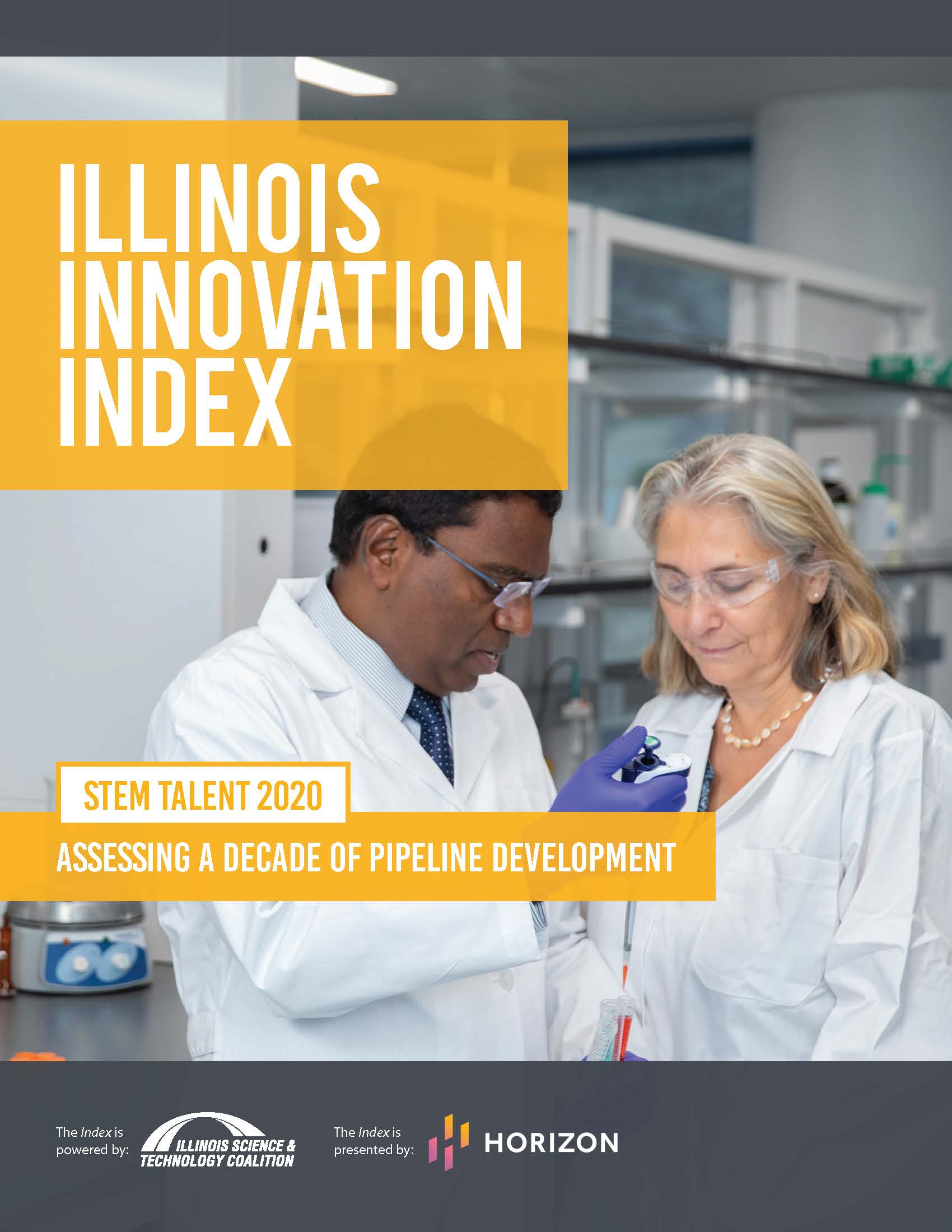2020 stem talent Index
Assessing a decade of pipeline development
executive summary
As Illinois moves into a new decade, our 2020 STEM Talent Index looks back at a decade of progress within the state’s science, technology, engineering, and mathematics (STEM) talent pipeline. Findings are mixed. Illinois has established itself as a national leader in computer science, but peer states are catching up. Fields at the intersection of mathematics, computing, and business—including data science—have also seen significant growth in Illinois. However, access to education in these growing areas, and the quality jobs for which they prepare students, is lacking for many Illinoisans.
Driven by advancements in technology and an evolving job market, STEM degree fields have grown steadily over the past decade. In 2019, Illinois awarded 24,861 bachelor’s, master’s, and doctoral degrees in STEM areas, a new record for the state. However, STEM degrees in Illinois have grown more slowly than the national trend over the past decade—dropping the state from 6th nationally in STEM degree production in 2010, to 7th in 2019.
Though overall STEM degree growth in Illinois has lagged behind the national trend, the state has seen significant growth in computer and information sciences, and interdisciplinary STEM fields. However, after maintaining its place as the 2nd largest producer of computer science degrees in the nation for much of the past decade, a drop in degree production in recent years slid the state to 3rd nationally in 2019.
While the growth of STEM degrees slowed over the past decade, Illinois has made significant progress to grow STEM jobs—adding over 90,000 since 2010. Illinois is among the national leaders in STEM job growth over the past decade, with only three states adding more jobs since 2010. As a result of this significant growth, Illinois moved from 8th nationally in STEM employment in 2010, to 7th in 2019.
Despite the overall progress made over the past decade, too many Illinoisans are still being left out of the STEM pipeline. Women, as well as Black and Latinx Illinoisans remain significantly underrepresented by both STEM degrees awarded and employment in STEM jobs. Though progress has been made within Illinois’ Latinx population over the past decade, progress growing representation among women and Black Illinoisans in STEM has been minimal.
New in the 2020 STEM Talent Index
The 2020 STEM Talent Index takes an in-depth look at biomedical and biotechnology talent in Illinois, assessing both degree production and job growth in the field. Further amplified by the COVID-19 pandemic, biomedical and biotechnology talent is key to both life-saving innovation and economic growth in the state. Similar to recent analyses in computer and data science, this Index also leverages LinkedIn data to examine retention of Illinois’ recent biomedical and biotechnology graduates.
Virtual Release Event: The State of STEM Talent 2020
Presentation Slides
Key Findings
STEM Talent Supply
- In 2019, Illinois awarded 24,861 bachelor’s, master’s, and doctoral degrees in STEM areas—a new record for the state. However, STEM degrees awarded in Illinois have grown by 4.7 percent annually since 2010, slower than national growth of 5.9 percent annually over the same period.
- The share of degrees awarded in STEM areas has grown from 15.1 percent in 2010, to 19.9 percent in 2019. However, the share of Illinois’ degrees awarded in STEM has consistently trailed the national average over the past decade.
- By degree production, STEM subject areas were led by engineering (6,945 degrees), computer and information sciences (5,228), and biological sciences (4,887) in 2019. Growth in STEM subject areas since 2010 is led by computer and information sciences (9.2 percent annual growth) and interdisciplinary studies (8.2 percent annual growth).
- While STEM degree production has grown substantially over the past decade, its growth has been limited in recent years by declining undergraduate enrollment in the state. Total undergraduate enrollment at Illinois colleges and universities fell by nearly 14 percent between 2013 and 2018.
STEM Talent Demand
- In 2019, the number of STEM jobs in Illinois reached 352,280, 7th most among states nationally. Illinois has added more than 90,000 STEM jobs over the past decade. STEM jobs in Illinois have grown by 3.5 percent annually since 2010, compared with 2.5 percent growth nationally.
- By percentage, no state among the top 10 in STEM employment has grown jobs more quickly than Illinois—and only three states nationally have added more STEM jobs—over the past decade.
- In 2019, STEM jobs in computer-related fields reached 174,450—roughly half of all STEM jobs in the state. These jobs have grown by 3.8 percent annually in Illinois since 2010, slightly faster than the national trend of 3.5 percent annual growth.
- The state’s fastest growing STEM occupations include those in data science and cybersecurity. Statisticians (17 percent annual growth), Operations Research Analysts (14 percent), and Information Security Analysts (13 percent) have all grown especially quickly over the past decade.
Diversity, Equity, and Inclusion in STEM
- In 2019, 37.1 percent of STEM degrees in Illinois were awarded to women. The share of STEM degrees awarded to women has grown by just 1 percent since 2010. Women are further underrepresented in STEM jobs, making up just 27.1 percent of Illinois’ STEM workforce.
- Despite making up 14.1 percent of the state’s population, just 5.7 percent of STEM degrees were awarded to Black students in 2019. The share of STEM degrees awarded to Black students in Illinois has fallen since 2010, when 6.1 percent of STEM degrees were awarded to Black students. Black professionals in Illinois make up just 6.5 percent of STEM jobs.
- More substantial progress has been made among Illinois’ Latinx population. In 2019, Illinois’ Latinx population made up 17.5 percent of the population and were awarded 12.1 percent of the STEM degrees, more than double the share awarded to Latinx students in 2010. Latinx professionals make up 8.5 percent of STEM jobs in Illinois.
Computer and Data Science in Depth
- Though the state remains a national leader in computer science talent, 2019 marked the second consecutive year in which degree production fell in Illinois. The state awarded 3,443 degrees in computer science in 2019, a decline of nearly 300 degrees from the state’s peak degree output of 3,733 in 2017.
- As a result of this decline, Illinois fell from the 2nd largest producer of computer science degrees nationally—a distinction the state held from 2010 through 2018—to 3rd.
- In 2019, Illinois awarded 4,574 data science-related degrees, 6th most among states nationally. Data science-related degrees in Illinois have grown by 4.2 percent annually since 2010, slower than national growth of 8.5 percent.
- 69,570 Illinois professionals were employed in software development & programming jobs in 2019, an increase of 20,000 since 2010. As a result of this growth, the state climbed from 9th among states nationally in 2010, to 7th in 2019.
- In 2019, 10,990 professionals in the state were employed in data science-related fields. Data science jobs in Illinois have more than tripled since 2010, growing by 12.7 percent annually— more than twice the national rate of 6.1 percent over the same period.
Biomedical and Biotechnology Talent
- In 2019, Illinois awarded 4,761 degrees in biomedical & biotechnology-related areas. Biomedical & biotechnology degrees have grown by 2 percent annually since 2010, slower than national growth of 4 percent over that period.
- Jobs in biomedical & biotechnology in Illinois reached 9,180 in 2019. Biomedical & biotechnology jobs have more than doubled since 2010, growing by 8.2 percent annually— significantly faster than national growth of 2.9 percent annually over the same period.
-
An estimated 72 percent of recent graduates in biomedical & biotechnology remain located in Illinois, with 64 percent located in the Chicago-area. Recent graduates are more than 10-times more likely to work in the Chicago-area, than in any other city.
**By submitting this form, you agree to receive future communications from the Illinois Science & Technology Coalition. If you have any issues accessing the report please email us at [email protected].
Archive
2019 – Talent Index
Computer and data science lead the way. New analysis shows retention is strong among recent grads.
2018 – Talent Index
Computer and data science lead the way. New analysis shows retention is strong among recent grads.
2017 – Talent Index
STEM, Computer science degrees reach record high
2016 – Talent Index
A comprehensive look at STEM degrees, talent migration, and skills in demand
2015 – Talent Index
New analysis sheds light on STEM talent supply and demand in Illinois
2014 – Talent Index
STEM attainment in Illinois and talent migration trends in Chicago
2013 – Talent Index
Talent in Illinois and Chicago: Data and recent trends

